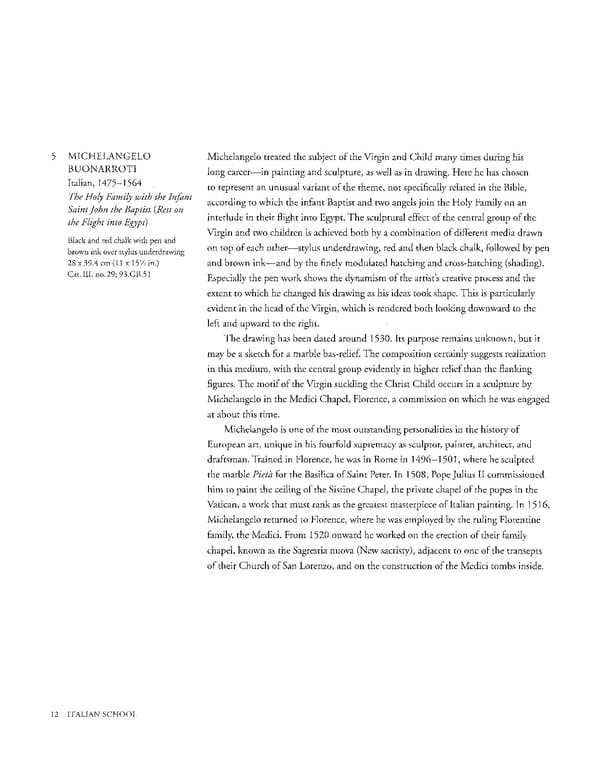5 MICHELANGELO Michelangelo treated the subject of the Virgin and Child many times during his BUONARROTI long career—in painting and sculpture, as well as in drawing. Here he has chosen Italian, 14751564 to represent an unusual variant of the theme, not specifically related in the Bible, The Holy Family with the Infant Saint John the Baptist (Rest on according to which the infant Baptist and two angels join the Holy Family on an the Flight into Egypt) interlude in their flight into Egypt. The sculptural effect of the central group of the Virgin and two children is achieved both by a combination of different media drawn Black and red chalk with pen and brown ink over stylus underdrawing on top of each other—stylus underdrawing, red and then black chalk, followed by pen 28 x 39.4 cm (11 x 15½ in.) and brown ink—and by the finely modulated hatching and crosshatching (shading). Cat. Ill, no.29; 93.GB.51 Especially the pen work shows the dynamism of the artist's creative process and the extent to which he changed his drawing as his ideas took shape. This is particularly evident in the head of the Virgin, which is rendered both looking downward to the left and upward to the right. The drawing has been dated around 1530. Its purpose remains unknown, but it may be a sketch for a marble basrelief. The composition certainly suggests realization in this medium, with the central group evidently in higher relief than the flanking figures. The motif of the Virgin suckling the Christ Child occurs in a sculpture by Michelangelo in the Medici Chapel, Florence, a commission on which he was engaged at about this time. Michelangelo is one of the most outstanding personalities in the history of European art, unique in his fourfold supremacy as sculptor, painter, architect, and draftsman. Trained in Florence, he was in Rome in 1496—1501, where he sculpted the marble Pieta for the Basilica of Saint Peter. In 1508, Pope Julius II commissioned him to paint the ceiling of the Sistine Chapel, the private chapel of the popes in the Vatican, a work that must rank as the greatest masterpiece of Italian painting. In 1516, Michelangelo returned to Florence, where he was employed by the ruling Florentine family, the Medici. From 1520 onward he worked on the erection of their family chapel, known as the Sagrestia nuova (New sacristy), adjacent to one of the transepts of their Church of San Lorenzo, and on the construction of the Medici tombs inside. 12 ITALIAN SCHOOL
 Masterpieces of the Getty Museum: Drawings Page 12 Page 14
Masterpieces of the Getty Museum: Drawings Page 12 Page 14